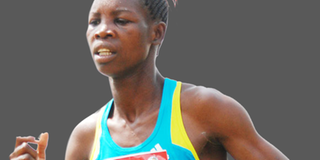Inzikuru became a beacon for Ugandan women’s sport

Dorcus Inzikuru
What you need to know:
WHAT IS STEEPLACHASE?
- The circuit has four ordinary barriers and one water jump. Over 3000m, each runner must clear a total of 28 ordinary barriers and seven water jumps.
- This entails seven complete laps after starting with a fraction of a lap run without barriers.
- The water jump is located on the back turn, either inside the inner lane or outside the outer lane. The barrier height is 914 mm (36 in) for men and 762 mm (30 in) for women.
Unlike those used in hurdling, steeplechase barriers do not fall over if hit; some runners actually step on top of them. - This slope rewards runners with more jumping ability, because a longer jump results in a shallower landing in the water.
Once upon a time, the name on everyone’s lips the world over was ‘Inzikuru’ and along with it the unbelieveable win she had scored for Uganda on the race tracks that will forever be historical, writes Ismail Dhakaba Kigongo
Not many Ugandans get the chance to have their names debated on the floor of the August House. Motions in Parliament are often moved in honour of national heroes who have passed on. Dorcus Inzikuru got this in 2005 way before her 25th birthday! It was a reward for an athletics career that climaxed in less than 10 minutes of sheer talent and dominance in Helsinki, Finland.
Inzzi, as she is fondly referred to, had won the first world athletics title in women’s 3000m steeplechase. The then 23-year-old clocked a time of nine minutes, 18 seconds and 24 micro seconds, which was the best time to be done by any female athlete over the distance.
She received a hero’s welcome upon her return and made a vow to build a house and help young athletes. The President answered the first call in a flash, by ordering the army to construct a house for her in Arua. He also gave her a heroine’s medal.
And why not? She changed the landscape, forever. The simple previously little known girl from Arua in Northern Uganda had at that World Championships race ended Uganda’s 33-year wait for an athletics world title. To this day, she is Uganda’s last medal winner at the event that occurs once every two years to follow in the footsteps of David Kamoga, who had won silver in Seville, Spain, eight years prior.
A sudden shooting star
Inzzi went from being an unknown to one of the greatest athletes Uganda has ever-known and only 1972 Olympic Gold medalist John Akii-Bua, compares. The ‘Arua Gazelle’ had arrived not only on front-pages here but also on the world stage. Her name became a reference for sports commentators and created such an effervescent brand for Uganda. Several Uganda Athletics Federation (UAF) officials used her as a reference for all young upcoming athletes.
Helsinki was a life-changing moment. Portrayed as innocent as they come, Inzikuru only became aware of the $60,000 (about Shs150m) prize after winning the final.
Two years prior to all this, the lady, whose first name is misspelt as Docus in her passport, had at the 2003 Afro-Asian Games finished behind Ethiopians Meseret Defar and Tirunesh Dibaba, two of the greatest female runners of all time, winning bronze, for she had not got the same acclaim. The warning signal of a world star, just 1.56m, was there but many missed it – beneath the innocence was a caged fighter no one dared to explore.
There was nothing the daughter of an Anglican priest could not achieve. She was the best at jumping over barriers then running straight. The third of eight children, who lost her two older brothers at the ages of eight and fourteen to typhoid and malaria, Inzzi has routinely spoken in many interviews of growing up in rural Vurra, Arua District without any coaches or shoes.
Gone as fast as she had appeared
Just when a blank cheque for the Helsinki feat was on its way, she disappeared only to resurface at a company event in Lugogo in a pink maternity dress in 2007.
What followed is an episode which is discussed despite it being a private affair. Inzikurru got married to Dr. Martin Bosco Acidri, a former sprinter. Together, they had a child as media reports swelled that she was receiving treatment for sinus infections and various allergies.
On her return from maternity leave, she won an 800m race in Namboole but has never recovered to become the competitor she was at 23. Stories about Inzzi’s marital strife are easier to find than a race she last won as she once sued her husband for violence only to withdraw the case later. Recently, the community intervened quickly as the world champion removed the roof of her house following a disagreement with the doctor, who was reportedly cheating on her inside the house.
Her response was, “Can’t someone change the iron sheets or tiles of their house?” A reminder that the innocence was not lost. What may be certainly lost however, is her ability to reign on the race tracks again.
==============================================
ACHIEVEMENTS
3000m Steeplechase
2005 World Championships, Gold (9:18.24)
2005 World Athletics Final, Gold
2006 Commonwealth Games, Gold (9:19.51
3000m
1999 World Youth Championships, 8th
5000m
1999 African Games, 6th
2000 World Junior Championships, Gold
2002 Commonwealth Games, 4th
2002 African Games, Silver
2003 Afro-Asian Games, Bronze
Cross Country
2000 World Junior Championships, 10th
2004 World Championships (short course), 38th
2005 World Championships (short course), 18th
2007 World Championships, DNF
Personal bests
800m, 2:02.00
One Mile, 4:36.05
3000m, 8:46.29
5000m, 15:05.30
2000m Steeplechase, 6:04.46
3000m Steeplechase, 9:15.04




